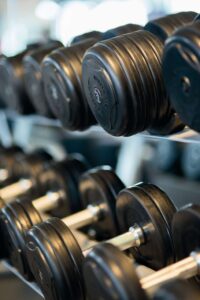With so many changes happening in a woman’s body as we approach menopause, the question is – how do we train during these years? Sadly, the answer to this question has been: women train the same way as they always did – like men. This is a poor approach as female bodies are not the same as men’s and they are not even the same as they were just a few years ago, while we still had our periods.
Menopause is often associated with a myriad of symptoms: lost muscle and bone density are the big ones that affect our athletic performance, then there’s also: hot flashes, mood swings, crime-scene level periods, fatigue, and brain fog just to name a few. We will focus on the first two in this article and how to slow down or even revert this process.
As athletes in their menopausal years, lost muscle mass becomes a big performance issue and if you do nothing about it, it only gets worse. After the age of 30, we are expected to lose up to 8% of our muscle mass each decade and this decline becomes even bigger after the age of 60.
Estrogen is the main female hormone and is anabolic, helping create forceful muscle contractions. As this important hormone’s levels decline, so do our muscles. Stopping this decline becomes a very important task that many female athletes overlook, blaming the decline in their performance on their aging bodies. It does not have to be this way. Incorporating 2-3 pure strength sessions a week will go a long way in helping women stay in their A-game.
Here’s an example of a strength workout that you can incorporate into your training schedule (see video playlist below)
Goblet Squats 3 x 8 progressing to 3 x 10, 3 x 12, 2 x 18
Box Jumps 3 x 4 progressing to 4 x 4
Kettlebell Swings 5 x 8 progressing to 6 x 8, 8 x 8
Speed Skater 3 x 20″ progressing to 3 x 30″, 3 x 40″
Single Leg Deadlift w weight 3 x 8 progressing to 3 x 10, 3 x 12
Assisted Pull Ups 3 x 6 progressing to 3 x 8
Shoulder Press 3 x 6 progressing to 3 x 10
Planks Variations 3 x 20″ progressing to 3 x 30″, 3 x 40″
Inchworms 3 x 4-6 progressing to 3 x 6-8, 3 x 8
The exercises should be done with plenty of rest (2 – 5 minutes) between the sets. Progression is necessary starting with low weight, low rep end and building up from there. If you have not been doing strength or had a break in your strength training for a month or more, you need to start from the beginning. Increase weight and/or number of reps after at least two weeks of working with the current set of parameters. Form comes before weight and the number of repetitions can increase.
Bone density is another huge variable that plays a major role as we age. Women can lose 1/5 of their bone density during the first 5-7 years of menopause. The result is that bones can become brittle and are more easily broken. A fall off the bike that 5 years ago would have caused nothing but a bruise, is more likely to result in a broken bone. Why is this happening and why are women at a higher risk? Again, this has to do with our hormones. Estrogen plays a major role in bone remodeling and as the levels flatline during menopause, we lose this hormone’s protection.
The good news is just like with the muscles, we can slow down or even reverse the effects of bone density loss. Our bodies will respond and adapt to the stress we put it under. Just as we stress our muscles to prevent muscle mass loss, we can do the same to our bones. The best exercises to promote bone growth are the ones against gravity. Sports like running, tennis, and basketball are great for bone building. Swimming and cycling are not as effective and if you are only a swimmer or only a cyclist, you better add some walking/jogging and strength sessions to your exercise routine as you do not get enough skeletal stress with your main sport.
Plyometrics is an excellent way to stress your bones and make them stronger. Here’s an example of a simple routine. Start with 30 seconds per exercise and gradually increase duration to 2-3 minute sessions adding more advanced exercises gradually and only one at a time (see video playlist below)
1. Jump in place (add left-right, front-back, and in square pattern)
2. Shuffle
3. Jump on one foot (add left-right, front-back, and in square pattern)
4. Tuck jumps
5. Skater jumps
6. Bar stool jumps
7. Lunge jumps
8. Burpees
More advanced plyometrics moves are in a playlist below.
Posture exercises become critical as well as poor posture puts unnecessary stress on our skeletal muscles, compromising the structure of our body. Here are some of my favorite postural exercises. Do a 5-10 minute routine every day.
1. Windmill
2. Floor Angels
3. Superman
4. Hip Lifts
5. Swan
6. Mermaid
7. Saw
8. Cat and Cow
9. Child’s Pose
Back exercises playlist can be found here:
here
A main goal of our sport is to stay in it as long as we possibly can, reaping the health benefits of training and competition. With small additions of strength and bone density routines to your normal training you will keep your body in the best possible shape and stay in your A-game for a very long time.
As always comments and feedback are welcome and if you need help putting your personalized routine to complement your triathlon training, send me a message.
Keep on moving!











